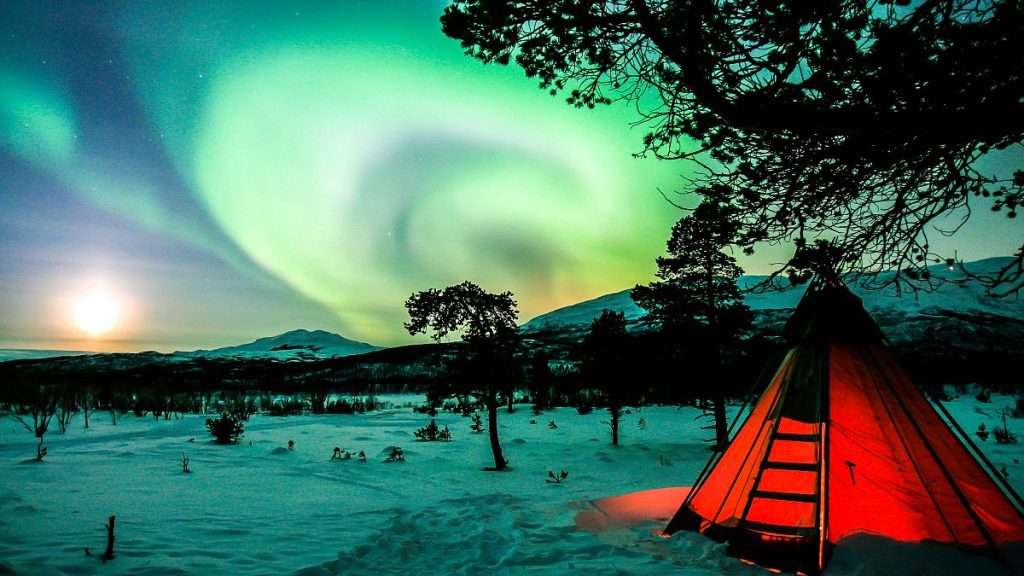The aurora borealis, commonly known as the Northern Lights, is set to dazzle the skies with increased intensity in 2025, offering a spectacular celestial display unmatched in the past decade. This surge in auroral activity is attributed to the sun’s heightened activity within its 11-year solar cycle, reaching a peak between 2024 and 2025. This period is characterized by a significant increase in sunspots, indicating amplified solar energy and a greater likelihood of vibrant auroral displays. This presents a unique opportunity for aurora enthusiasts to witness this breathtaking phenomenon in all its glory.
The Northern Lights are formed through the dynamic interaction between solar wind, a stream of charged particles emitted by the sun, and Earth’s atmosphere. As these particles approach Earth, they are guided by the planet’s magnetic field towards the polar regions, typically confining the aurora borealis to areas within the Arctic Circle. However, during periods of heightened solar activity, such as coronal mass ejections (CMEs), the aurora’s visibility expands southward, extending its reach to lower latitudes and allowing people in regions further south to witness this captivating spectacle.
The vibrant colors of the aurora, ranging from red and green to magenta and blue, are a result of the solar wind interacting with different gas molecules in the Earth’s atmosphere. Oxygen molecules at varying altitudes produce green or red hues, while nitrogen molecules contribute blue and purple shades. This interplay of gases and altitudes creates the mesmerizing tapestry of colors that dance across the night sky.
The increased solar activity in 2025 significantly enhances the chances of witnessing the Northern Lights, particularly around the March and October equinoxes. The stronger solar flares translate into brighter and more frequent auroral displays, making it an ideal time to plan an aurora-chasing adventure. While traditional viewing locations within the Arctic Circle, such as Lapland in Finland, Tromsø in Norway, Abisko in Sweden, and Thingvellir National Park in Iceland, continue to offer optimal viewing conditions, the heightened solar activity also increases the likelihood of sightings further south, extending the opportunity to witness this phenomenon to a wider audience.
For those seeking the best aurora viewing experiences, clear skies and minimal light pollution are crucial. Traditional aurora hotspots within the Arctic Circle, known for their dark skies and pristine viewing conditions, remain ideal destinations. Lapland in Finland, with its expansive wilderness and dedicated aurora viewing facilities, offers a prime location for immersing oneself in this celestial spectacle. Tromsø in Norway, known as the “Arctic Capital,” boasts a vibrant city atmosphere alongside readily accessible aurora viewing points. Abisko National Park in Sweden, recognized for its consistently clear skies and dedicated aurora sky station, provides an optimal setting for observing the Northern Lights. Thingvellir National Park in Iceland offers a unique opportunity to combine aurora viewing with exploring other natural wonders, such as volcanoes, geysers, and hot springs.
Beyond these established locations, the surge in solar activity expands viewing possibilities to other regions. Northern parts of the UK, Germany, and even Italy may experience glimpses of the aurora borealis. International Dark Sky Parks, designated areas committed to preserving night sky quality, offer excellent opportunities for aurora viewing closer to home. Europe’s largest dark sky park in Northumberland, UK, presents an ideal location for seeking out the aurora borealis without travelling to the Arctic Circle.
In conclusion, 2025 presents an exceptional opportunity to witness the awe-inspiring Northern Lights. The heightened solar activity promises more frequent and vibrant displays, extending viewing opportunities further south. Whether venturing to the traditional aurora hotspots within the Arctic Circle or seeking out dark sky locations closer to home, 2025 is poised to be a truly remarkable year for aurora enthusiasts. The heightened solar activity increases the likelihood of witnessing this mesmerizing celestial display, making it a prime time to embark on an aurora-chasing adventure and create unforgettable memories under the magical glow of the Northern Lights.


